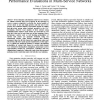Free Online Productivity Tools
i2Speak
i2Symbol
i2OCR
iTex2Img
iWeb2Print
iWeb2Shot
i2Type
iPdf2Split
iPdf2Merge
i2Bopomofo
i2Arabic
i2Style
i2Image
i2PDF
iLatex2Rtf
Sci2ools
GLOBECOM
2006
IEEE
2006
IEEE
Efficient Approximations for Call Admission Control Performance Evaluations in Multi-Service Networks
—Several dynamic call admission control (CAC) schemes for cellular networks have been proposed in the literature to reserve resources adaptively to provide the desired quality of service (QoS) to not only high priority calls but also to low priority ones. Efficient adaptive reservations depend on reliable and up-to-date system status feedback provided to the CAC mechanism. However exact analysis of these schemes using multidimensional Markov chain models are intractable in real time due to the need to solve large sets of flow equations. Hence performance metrics such as call blocking probabilities of various QoS classes are generally evaluated using one dimensional Markov chain models assuming that channel occupancy times for all QoS classes have equal mean values and all arriving calls have equal capacity requirements. In this paper we re-evaluate the analytical methods to compute call blocking probabilities of various QoS classes for several widely known CAC schemes by relaxing the...
Related Content
| Added | 11 Jun 2010 |
| Updated | 11 Jun 2010 |
| Type | Conference |
| Year | 2006 |
| Where | GLOBECOM |
| Authors | Emre A. Yavuz, Victor C. M. Leung |
Comments (0)

